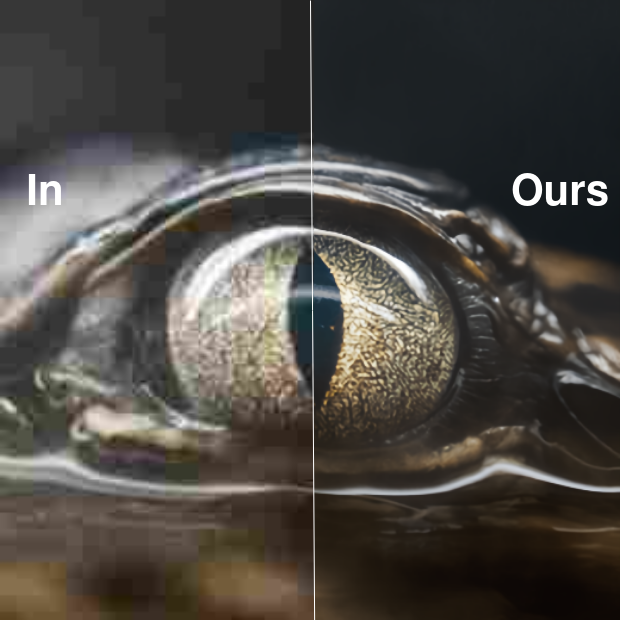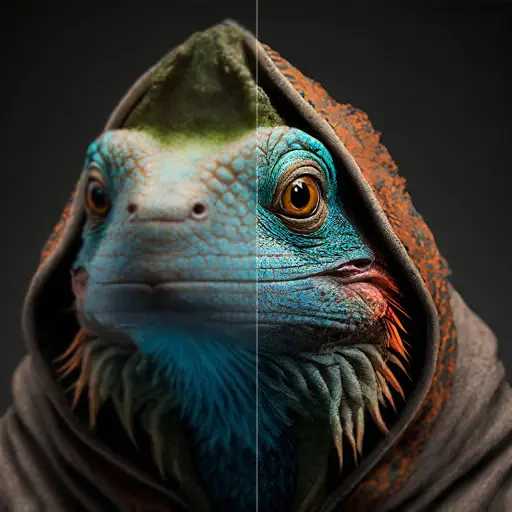seesr
Maintainer: cswry

36

| Property | Value |
|---|---|
| Run this model | Run on Replicate |
| API spec | View on Replicate |
| Github link | View on Github |
| Paper link | View on Arxiv |
Create account to get full access
Model overview
seesr is an AI model developed by cswry that aims to perform semantics-aware real-world image super-resolution. It builds upon the Stable Diffusion model and incorporates additional components to enhance the quality of real-world image upscaling. Unlike similar models like supir, supir-v0q, supir-v0f, real-esrgan, and gfpgan, seesr focuses on leveraging semantic information to improve the fidelity and perception of the upscaled images.
Model inputs and outputs
seesr takes in a low-resolution real-world image and generates a high-resolution version of the same image, aiming to preserve the semantic content and visual quality. The model can handle a variety of input images, from natural scenes to portraits and close-up shots.
Inputs
- Image: The input low-resolution real-world image
Outputs
- Output image: The high-resolution version of the input image, with improved fidelity and perception
Capabilities
seesr demonstrates the ability to perform semantics-aware real-world image super-resolution, preserving the semantic content and visual quality of the input images. It can handle a diverse range of real-world scenes, from buildings and landscapes to people and animals, and produces high-quality upscaled results.
What can I use it for?
seesr can be used for a variety of applications that require high-resolution real-world images, such as photo editing, digital art, and content creation. Its semantic awareness allows for more faithful and visually pleasing upscaling, making it a valuable tool for professionals and enthusiasts alike. Additionally, the model can be utilized in applications where high-quality image assets are needed, such as virtual reality, gaming, and architectural visualization.
Things to try
One interesting aspect of seesr is its ability to balance the trade-off between fidelity and perception in the upscaled images. Users can experiment with the various parameters, such as the number of inference steps and the guidance scale, to find the right balance for their specific use cases. Additionally, users can try manually specifying prompts to further enhance the quality of the results, as the automatic prompt extraction by the DAPE component may not always be perfect.
This summary was produced with help from an AI and may contain inaccuracies - check out the links to read the original source documents!
Related Models

real-esrgan

1.7K
real-esrgan is an AI model developed by the creator cjwbw that focuses on real-world blind super-resolution. This means the model can upscale low-quality images without relying on a reference high-quality image. In contrast, similar models like real-esrgan and realesrgan also offer additional features like face correction, while seesr and supir incorporate semantic awareness and language models for enhanced image restoration. Model inputs and outputs real-esrgan takes an input image and an upscaling factor, and outputs a higher-resolution version of the input image. The model is designed to work well on a variety of real-world images, even those with significant noise or artifacts. Inputs Image**: The input image to be upscaled Outputs Output Image**: The upscaled version of the input image Capabilities real-esrgan excels at enlarging low-quality images while preserving details and reducing artifacts. This makes it useful for tasks such as enhancing photos, improving video resolution, and restoring old or damaged images. What can I use it for? real-esrgan can be used in a variety of applications where high-quality image enlargement is needed, such as photography, video editing, digital art, and image restoration. For example, you could use it to upscale low-resolution images for use in marketing materials, or to enhance old family photos. The model's ability to handle real-world images makes it a valuable tool for many image-related projects. Things to try One interesting aspect of real-esrgan is its ability to handle a wide range of input image types and qualities. Try experimenting with different types of images, such as natural scenes, portraits, or even text-heavy images, to see how the model performs. Additionally, you can try adjusting the upscaling factor to find the right balance between quality and file size for your specific use case.
Updated Invalid Date

swin2sr

3.5K
swin2sr is a state-of-the-art AI model for photorealistic image super-resolution and restoration, developed by the mv-lab research team. It builds upon the success of the SwinIR model by incorporating the novel Swin Transformer V2 architecture, which improves training convergence and performance, especially for compressed image super-resolution tasks. The model outperforms other leading solutions in classical, lightweight, and real-world image super-resolution, JPEG compression artifact reduction, and compressed input super-resolution. It was a top-5 solution in the "AIM 2022 Challenge on Super-Resolution of Compressed Image and Video". Similar models in the image restoration and enhancement space include supir, stable-diffusion, instructir, gfpgan, and seesr. Model inputs and outputs swin2sr takes low-quality, low-resolution JPEG compressed images as input and generates high-quality, high-resolution images as output. The model can upscale the input by a factor of 2, 4, or other scales, depending on the task. Inputs Low-quality, low-resolution JPEG compressed images Outputs High-quality, high-resolution images with reduced compression artifacts and enhanced visual details Capabilities swin2sr can effectively tackle various image restoration and enhancement tasks, including: Classical image super-resolution Lightweight image super-resolution Real-world image super-resolution JPEG compression artifact reduction Compressed input super-resolution The model's excellent performance is achieved through the use of the Swin Transformer V2 architecture, which improves training stability and data efficiency compared to previous transformer-based approaches like SwinIR. What can I use it for? swin2sr can be particularly useful in applications where image quality and resolution are crucial, such as: Enhancing images for high-resolution displays and printing Improving image quality for streaming services and video conferencing Restoring old or damaged photos Generating high-quality images for virtual reality and gaming The model's ability to handle compressed input super-resolution makes it a valuable tool for efficient image and video transmission and storage in bandwidth-limited systems. Things to try One interesting aspect of swin2sr is its potential to be used in combination with other image processing and generation models, such as instructir or stable-diffusion. By integrating swin2sr into a workflow that starts with text-to-image generation or semantic-aware image manipulation, users can achieve even more impressive and realistic results. Additionally, the model's versatility in handling various image restoration tasks makes it a valuable tool for researchers and developers working on computational photography, low-level vision, and image signal processing applications.
Updated Invalid Date

aura-sr

5
aura-sr is a GAN-based super-resolution model designed to upscale real-world images. It is based on the GigaGAN approach and can produce impressive results for certain types of images. The model is developed by zsxkib and is available through the Replicate platform. Similar models like SeeSR, ArbSR, ESRGAN, and Real-ESRGAN also aim to improve image super-resolution in various ways. Model inputs and outputs The aura-sr model takes an input image file and a scale factor as its inputs. The scale factor determines how much the image will be upscaled, with options for 2, 4, 8, 16, or 32 times the original size. The model outputs a higher-resolution version of the input image. Inputs image**: The input image file to be upscaled. scale_factor**: The factor by which to upscale the image (2, 4, 8, 16, or 32). max_batch_size**: Controls the number of image tiles processed simultaneously. Higher values may increase speed but require more GPU memory. Outputs Output**: The upscaled image file. Capabilities aura-sr is particularly effective at upscaling PNG, lossless WebP, and high-quality JPEG XL images. It can handle different sized jobs and work quickly, making it a useful tool for tasks that require enlarging images while preserving quality. What can I use it for? The aura-sr model can be used to upscale AI-generated images or high-quality photographs, making them larger and clearer without losing important details. This can be useful for a variety of applications, such as creating larger promotional materials, improving image quality for websites or social media, or enhancing the visual impact of visualizations and data presentations. Things to try While aura-sr is a powerful tool, it does have some limitations. It works best with certain image formats and may not perform well on heavily compressed or low-quality images. Experimenting with different input images and scale factors can help you find the optimal use cases for this model.
Updated Invalid Date

rudalle-sr

480
The rudalle-sr model is a real-world blind super-resolution model based on the Real-ESRGAN architecture, which was created by Xintao Wang, Liangbin Xie, Chao Dong, and Ying Shan. This model has been retrained on the ruDALL-E dataset by cjwbw from Replicate. The rudalle-sr model is capable of upscaling low-resolution images with impressive results, producing high-quality, photo-realistic outputs. Model inputs and outputs The rudalle-sr model takes a single input - an image file - and an optional upscaling factor. The model can upscale the input image by a factor of 2, 3, or 4, producing a higher-resolution output image. Inputs Image**: The input image to be upscaled Outputs Output Image**: The upscaled, high-resolution version of the input image Capabilities The rudalle-sr model is capable of producing high-quality, photo-realistic upscaled images from low-resolution inputs. It can effectively handle a variety of image types and scenes, making it a versatile tool for tasks like image enhancement, editing, and content creation. What can I use it for? The rudalle-sr model can be used for a wide range of applications, such as improving the quality of low-resolution images for use in digital art, photography, web design, and more. It can also be used to upscale images for printing or display on high-resolution devices. Additionally, the model can be integrated into various image processing pipelines or used as a standalone tool for enhancing visual content. Things to try With the rudalle-sr model, you can experiment with upscaling a variety of image types, from portraits and landscapes to technical diagrams and artwork. Try adjusting the upscaling factor to see the impact on the output quality, and explore how the model handles different types of image content and detail.
Updated Invalid Date